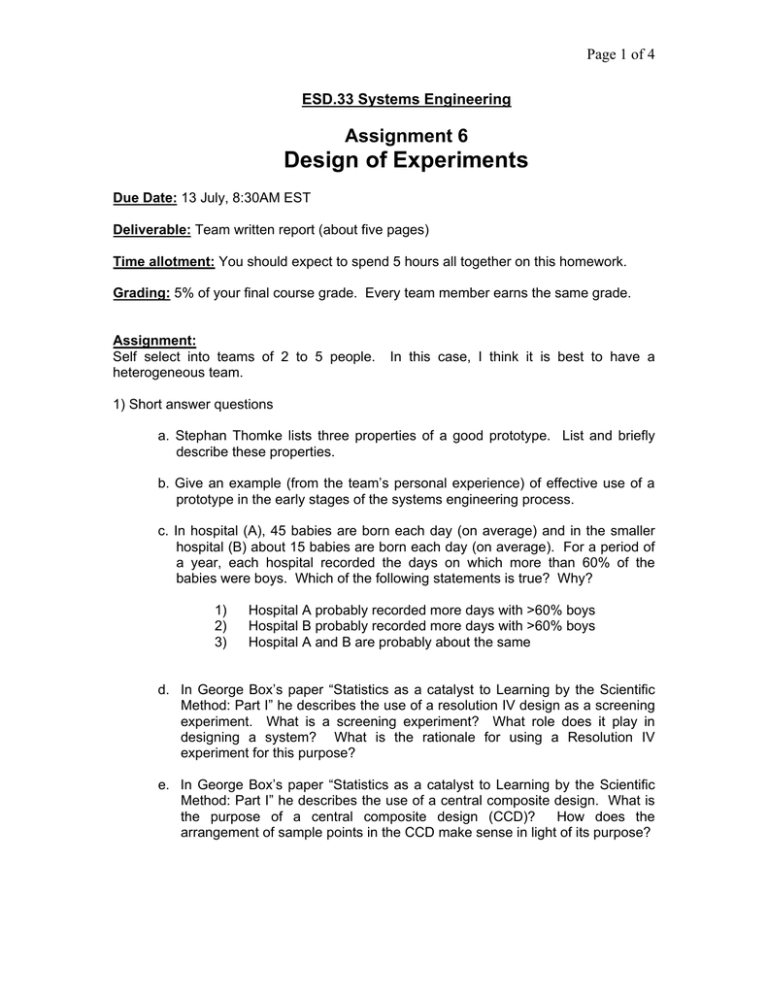Design of Experiments Assignment 6 Page 1 of 4
advertisement

Page 1 of 4 ESD.33 Systems Engineering Assignment 6 Design of Experiments Due Date: 13 July, 8:30AM EST Deliverable: Team written report (about five pages) Time allotment: You should expect to spend 5 hours all together on this homework. Grading: 5% of your final course grade. Every team member earns the same grade. Assignment: Self select into teams of 2 to 5 people. heterogeneous team. In this case, I think it is best to have a 1) Short answer questions a. Stephan Thomke lists three properties of a good prototype. List and briefly describe these properties. b. Give an example (from the team’s personal experience) of effective use of a prototype in the early stages of the systems engineering process. c. In hospital (A), 45 babies are born each day (on average) and in the smaller hospital (B) about 15 babies are born each day (on average). For a period of a year, each hospital recorded the days on which more than 60% of the babies were boys. Which of the following statements is true? Why? 1) 2) 3) Hospital A probably recorded more days with >60% boys Hospital B probably recorded more days with >60% boys Hospital A and B are probably about the same d. In George Box’s paper “Statistics as a catalyst to Learning by the Scientific Method: Part I” he describes the use of a resolution IV design as a screening experiment. What is a screening experiment? What role does it play in designing a system? What is the rationale for using a Resolution IV experiment for this purpose? e. In George Box’s paper “Statistics as a catalyst to Learning by the Scientific Method: Part I” he describes the use of a central composite design. What is the purpose of a central composite design (CCD)? How does the arrangement of sample points in the CCD make sense in light of its purpose? Page 2 of 4 2) The two sub-problems below concern regression a. The data below come from an experiment on a prosthesis in which cable tension was varied systematically and grip force was measured. Perform linear regression on this data. What is the equation relating the two variables? What is the R squared value? What does it mean? What is the F ratio? What does it mean? What is the p-value for the slope of the regression line? What conclusion do you draw? Plot the residuals. Cable Tension (lbs) 12 12 12 12 12 21 21 21 21 21 15 15 15 15 15 27 27 27 27 27 6 6 6 6 Prosthetic Grip Force (lbs) 2.010771454 3.098565848 2.406333052 2.274479186 2.406333052 3.988579442 4.252287174 3.988579442 4.515994905 4.450067973 4.186360241 2.670040784 3.131529314 2.966711982 3.329310113 5.504898899 6.296022095 6.098241296 6.361949027 6.658620226 2.14262532 0.955940527 0.988903994 1.153721326 6 24 24 24 24 24 9 9 9 9 9 18 18 18 18 18 3 3 3 3 3 30 30 30 30 30 continued 0.955940527 4.515994905 4.812666104 5.471935433 5.175264235 5.274154634 2.637077317 2.076698387 1.549282924 1.450392524 1.58224639 4.186360241 3.560054378 4.153396774 3.82376211 3.856725576 1.186684793 0.494451997 0.527415463 0.824086662 0.725196262 5.669716232 6.790474091 6.856401024 5.933423963 6.856401024 b. The data below come from an experiment in which the wrap angle over a capstan is varied and the ratio of tension to weight is measured. Perform linear regression on this data. What is the equation relating the two variables? What is the R squared value? What does it mean? Plot the residuals. How do your conclusions differ from those in sub-problem (a)? What do you suggest doing to further analyze this data? Page 3 of 4 Theta T W Theta 0 30 60 90 120 150 180 210 240 270 300 330 360 T/W 1 1.06708 1.13966 1.215042 1.296548 1.38352 1.436327 1.57536 1.701036 1.7938 1.914129 2.002529 2.179542 Page 4 of 4 3) The template “paper_airplane.pdf” contains a template for a paper airplane. It has four variables that can be changed independently between three different levels each. The template also has a nine run orthogonal array printed on its side (Taguchi’s L9 or Plackett Burman P-B3,9). Carry out the experiment described. Preferably, your team should perform at least one true replicate with a different thrower. Preferably, your team should randomize the throw order of the 9 treatment conditions. You may need to mark off distances on the floor with tape or a tape measure. a) List the data along with any pertinent notes concerning the conduct of the experiment. b) Create plots indicating the main effects of the factors. c) Compute confidence intervals on the main effects. d) Select the values of the variables that give the longest flight. Manufacture that plane and fly it at least three times. How does its flight compare to the predicted flight distance based on an additive model? e) Select at least one two factor interaction of interest and use a full factorial design 22 to study it.

